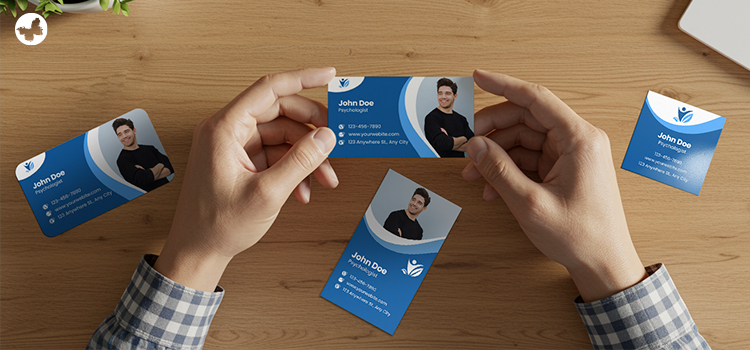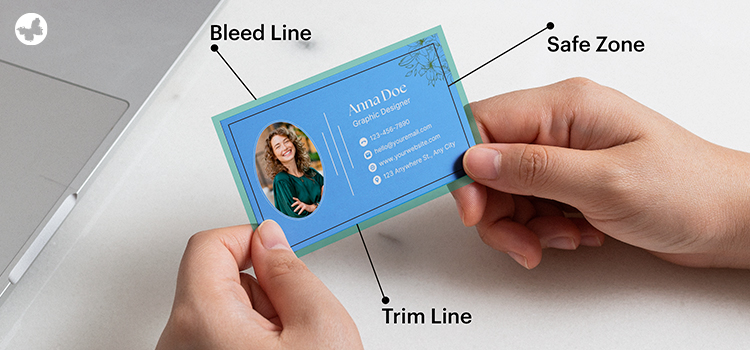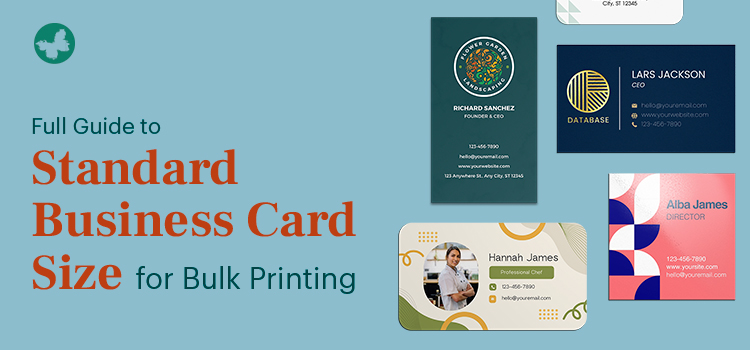Business cards provide a physical representation of your brand and are essential for professional networking. The proper business card dimensions can improve the design, avoid crowding, and guarantee that the card fits neatly into standard card holders or wallets. The ideal size guarantees a balance between aesthetic appeal, readability, and usefulness.
So, selecting the standard business card size is crucial if you want to leave a lasting impression. Especially if you want to order in bulk, the size and dimensions of the business card will be a key component to consider. This blog post shares important tips about ordering standard business card size in bulk for your business.
Contents
Why Size Is Key in Bulk Business Card Orders?
Larger orders frequently result in cheaper per-card prices because of bulk discounts, and uniform sizes guarantee a consistent brand image and prevent confusion from different designs. Size is important when ordering business cards in bulk for consistency, cost-effectiveness, and making sure there is enough room for the information that is required.
Purchasing in bulk can help you avoid having to place smaller, more frequent orders, which can end up costing more money over time. When placing bulk orders, businesses should think about their future requirements, accounting for networking events, team changes, and possible growth.
Read More: Business Card Quantity You Should Print As B2B Professionals
Wholesale Standard Business Card Sizes

Every business has different sectors, such as the sales department, marketing team, finance department, and everything in between. There are several team members in each of these departments and teams who require business cards to advertise their offerings. Anyone would get a headache just designing business cards for every team member in those departments.
You can save time and money by placing bulk orders from a single print supplier and maintaining consistency in your branding, colour, and design strategies. To ensure that your business cards are functional and helpful for all members of your company, it is crucial to place your order at the standard size and dimensions. Let’s check the list of the most common sizes of business cards.
1. Rectangular 3.5″ x 2″ (88.9 x 50.8 mm)
In many places, including the US and Canada, a 3.5″ x 2″ (88.9 x 50.8 mm) business card is the typical size. Because it fits neatly into wallets and cardholders and offers enough space for important information and branding, this size was selected for its efficiency.
Due to their widespread recognition and acceptance, such dimensions can be used in a variety of professional and networking contexts. Your contact details are always accessible thanks to this size’s easy storage and carrying capabilities.
2. Square (2.5″ x 2.5″ or 63.5 x 63.5 mm)
When compared to typical rectangular cards, the square-shaped business card offers a unique visual appeal that increases its visibility. Even though it is small, it is manageable to carry and store, and it still has enough room for important data.
Creative and distinctive design layouts that successfully convey the essence of your brand are made possible by the square format. Don’t worry about the limited space; by printing on both sides of the card, you can make the most of your messaging area.
3. Mini (2.75″ x 1.1″ or 70 x 28 mm)
They are easy to carry and store due to their small size (2.75″ x 1.1″ or 70 x 28 mm), especially in wallets or cardholders. Their size naturally draws attention to the important details, resulting in designs that are more streamlined and clean.
This business card’s unique shape can make it more memorable. Plus, smaller cards may be a more affordable choice, particularly for startups. In addition to being frequently used as business cards, they can also be used as bookmarks or hang tags.
4. Rounded Corners
Shape is the primary focus of this type, not just size. Cards with rounded corners stand out from those with square corners because they have a more modern appearance and feel. Their appearance is friendlier and more welcoming. From a user perspective, the smoother edges can create a more enjoyable tactile experience.
Their distinctive form attracts attention and creates a lasting impression. They can be used with both simple and more complex layouts, and they look good with a variety of design styles. Incorporating social media icons, which frequently have rounded logos, can perfectly match the rounded shape.
Bleed, Trim and Safe Zones

To create a polished, tidy final product, the bleed, trim, and safe zones are essential for business card design. These are some of the essential print design terminologies. You need to follow these basic rules to create a perfect print project. Let’s give a quick explanation of each to prevent any confusion:
- Bleed Area: Your design extends beyond the card’s trim size in a bleed area. If the cut is a little off, this guarantees that there won’t be any white edges when the card is printed and cut. A typical bleed area is three millimetres (0.125 inches) on all sides.
- Trim: The business card’s trim line is where the cut should be made. It indicates the card’s ultimate dimensions. There may be small variations, but this is the line the printer will aim to cut the card. The standard trim size for business cards in the United States is 3.5 x 2 inches (89 x 51 mm).
- Safe Area: To prevent being cut off during printing, all significant text and design components should be positioned in this section of the card. In most cases, it is smaller than the bleed area.
Final Printing Tips For Standard Business Card Sizes
Even though the sizes listed above are typical, you can also select business cards in a variety of other shapes and sizes to fit the aesthetic of your company. The most crucial thing to keep in mind is that these dimensions and sizes differ by region. For example, while 88.9 mm x 50.8 mm is standard in the US and Canada, the European standard is 85 mm x 55 mm, and the Japanese standard is 91 mm x 55 mm. Please use these guidelines to ensure that your bulk order is perfect and that the business card size and shape are standard:
- The most crucial thing to think about before completing your business card bulk order is choosing the standard size according to your business and regional requirements.
- Make sure your graphics and images have a proper resolution (such as 300 DPI) when getting your design ready for printing to prevent pixelation.
- Your brand identity is crucial, and the standard size you choose should reflect that. Selecting a distinctive size or shape will better reflect your company.
- A business card that fits comfortably in a pocket, wallet, or cardholder is said to be functional.
- Variations in size or shape can have an impact on printing expenses. Your available budget will influence the cardstock thickness and print finishes you select, so it is crucial to consider it.
Read More: Preparing Print Files: 5 Simple Steps to a Successful Print
Conclusion
Observe all of the aforementioned guidelines when printing standard business cards in bulk for your business. Verify every detail before finalizing your order to prevent additional fees. However, using discounts to save money is possible with bulk orders. ButterflyGP provides affordable rates for your large purchases. To ensure that your standard business cards are of the highest quality, our expert design and print teams take over the responsibility of your print project. While we create the beautiful final products, you can focus on other marketing plans.
